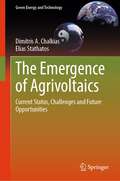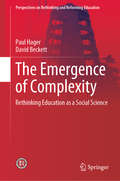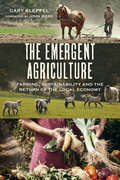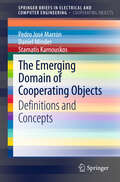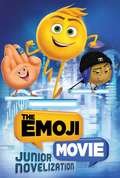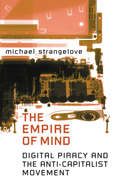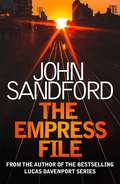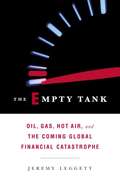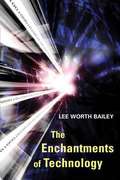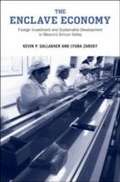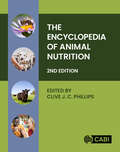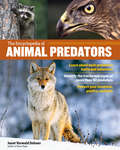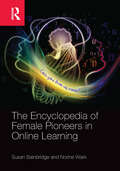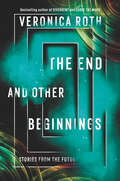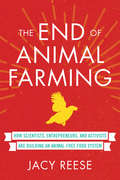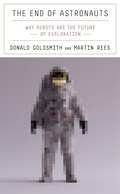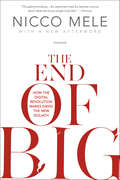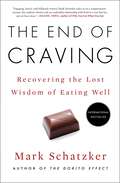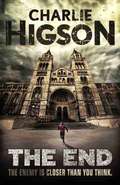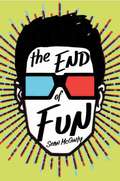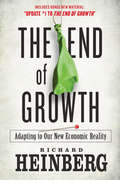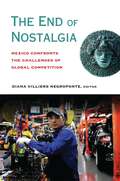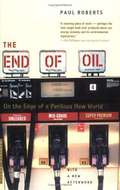- Table View
- List View
The Emergence of Agrivoltaics: Current Status, Challenges and Future Opportunities (Green Energy and Technology)
by Dimitris A. Chalkias Elias StathatosThis book assists in the adoption of the sustainable cross-sectoral nexus approach of agrivoltaics, which can provide a quite significant untapped potential for the sustainable development of humanity. Increasing demand for water, energy and food, due to population growth and urbanization, is aggravated by unprecedented extreme weather and climatic conditions. This situation is likely to undermine the sustainable and peaceful development of humanity. Today, more than ever, there is an imperative need to support the identification and development of practical solutions, where the use of a nexus approach can lead to improved outcomes in the integrated management of water–energy–food–ecosystem (WEFE) resources. This book disseminates the current knowledge of the modern approach of agrivoltaics, providing a comprehensive state of the art on the field, discussing the current status, the challenges and the future perspectives for their further development. This new currently in-depth unexplored topic will be covered thoroughly by the present book, which will attract the readership of both the scientific and industrial research communities, even of people who are dealing with cultivations, promoting the development in the field, from conceptual designs to practical realizations.
The Emergence of Complexity: Rethinking Education as a Social Science (Perspectives on Rethinking and Reforming Education)
by Paul Hager David BeckettThis book centres on a broadened view of complexity that will enrich engagement with complexity in the social sciences. The key idea is to employ complexity theory to develop a holistic account of practice, agency and expertise. In doing so, the book acknowledges and builds upon the relational character of reductive accounts. It draws upon recent theoretical work on complexity, emergence and relationality to develop a novel account of practice, agency and expertise in and for workplaces. Biological, psychological and social aspects of these are integrated. This novel account overcomes problems in current views of practice, agency and expertise, which suffer from reductive, or fragmented, analyses, based upon individuals, groups, or networks. In retrieving the experiential richness of human activity – often esteemed as the basis of generative and creative life – this book shows how complexity both emerges from, and is, a non-reductive feature of, human experience, especially in daily work.“…an ambitiously wide-ranging volume, questioning the key tenets of respected approaches ….. and offering ….. ‘novel accounts’, which draw on features of complexity thinking…. …But they go further than any of us in their argument that: ‘whatever reductive moves are made, they ‘flow’ from holistic accounts of relationality which have already affectively engaged the purposes of a co-present group.’ This is the intellectual contribution that is built consistently and persuasively across the chapters.” Professor Emerita Anne Edwards, Oxford University"Hager and Beckett have written a book that will challenge more commonly held notions of agency, practice, skills, and learning. Centering their argument on complexity theory or, as they prefer, complexity thinking, Hager and Beckett argue that it is through relations that we raise questions about, gather data from, and make working sense of the complexity that surrounds us. Groups then, particularly small groups, hold and implement agentive power. And what the authors call co-present groups—ones in which holistic relationality occurs socially, and affectively in distinctive places—“draw us closer to each other, and harness our normativity by enabling negotiability and reason-giving.” If your field of study involves anything remotely sociocultural in nature or if you are just interested in the complex ways we engage as humans with our worlds, you should find a place for this book in your library."Bob Fecho, Teachers College, Columbia University, New York NY, USA
The Emergent Agriculture
by Gary Kleppel John IkerdLong embraced by corporations who are driven only by the desire for profit, industrial agriculture wastes precious resources and spews millions of tons of greenhouse gases into the atmosphere each year, exacerbating climate change and threatening the very earth and water on which we depend. However, this dominant system, from which Americans obtain most of their food, is being slowly supplanted by a new paradigm.The Emergent Agriculture is a collection of fourteen thematic essays on sustainability viewed through the lens of farming. Arguing that industrial food production is incompatible with the realities of nature, science, and ethics, this lyrical narrative makes the case for a locally based food system which is: Stable in the face of economic uncertainty Resilient in the face of environmental variability Grounded in stewardship of the land, on attaching value to food and the craft involved in producing it, and on respecting the dignity of farmers, consumer,s and livestockA revolution in food production is underway. Written from the vantage point of an ecologist who is also a farmer, The Emergent Agriculture is essential reading for anyone interested in food security and the potential for growing local economies. Food for thought about the future of food.Gary Kleppel is a professor of biology at the SUNY Albany, where he focuses on sustainable agriculture, conservation-based grazing, and the ecology of human-dominated landscapes. He and his wife Pam are owners of Longfield Farm, where they produce grass-fed lamb, wool, free range chickens and eggs, and artisanal breads.
The Emerging Domain of Cooperating Objects
by Stamatis Karnouskos Daniel Minder Pedro José MarrónThis book provides a classification of current and future applications for the domain of Cooperating Objects. The book has been created with a very strong participation of the industry and taking into account current research trends and industrial roadmaps
The Emoji Movie Junior Novelization
by Tracey West Style GuideDiscover the world hidden inside your smartphone in this retelling of The Emoji Movie, featuring an eight-page color insert with images from the film! The Emoji Movie pops into theaters on July 28, 2017!The Emoji Movie unlocks the never-before-seen secret world inside your smartphone. Hidden within the messaging app is Textopolis, a bustling city where all your favorite Emojis live, hoping to be selected by the phone’s user. In this world, each Emoji has only one facial expression—except for Gene, an exuberant Emoji who was born without a filter and is bursting with multiple expressions. Determined to become “normal” like the other Emojis, Gene enlists the help of his handy best friend Hi-5 and the notorious rebel Emoji Jailbreak. Together, they embark on an epic “app-venture” through the apps on the phone, each its own wild and fun world, to find the code that will fix Gene. But when a greater danger threatens the phone, the fate of all Emojis depends on these three unlikely friends who must save their world before it’s deleted forever. The Emoji Movie © 2017 Sony Pictures Animation Inc. All Rights Reserved. emoji® is a registered trademark of emoji company GmbH used under license
The Emperor of Scent: A True Story of Perfume and Obsession
by Chandler BurrThe Emperor of Scent tells of the scientific maverick Luca Turin, a connoisseur and something of an aesthete who wrote a bestselling perfume guide and bandied about an outrageous new theory on the human sense of smell. Drawing on cutting-edge work in biology, chemistry, and physics, Turin used his obsession with perfume and his eerie gift for smell to turn the cloistered worlds of the smell business and science upside down, leading to a solution to the last great mystery of the senses: how the nose works.
The Empire of Mind
by Michael StrangeloveWhere many critics see the Internet as an instrument of corporate hegemony, Michael Strangelove sees something else: an alternative space inhabited by communities dedicated to anarchic freedom, culture jamming, alternative journalism, and resistance to authoritarian forms of consumer capitalism and globalization. In The Empire of Mind, "Dr. Strangelove," the scholar Canadian Business referred to as the "acknowledged dean of Internet entrepreneurs" and Wired called "the Canadian guru of Internet advertising," presents the compelling argument that the Internet and new digital communication technology actually undermine the power of capital, producing an alternative symbolic economy.Strangelove contends that the Internet breaks with the capitalist logic of commodification and that, while television produces a passive consumer audience, Internet audiences are more active, creative, and subversive. Writers, activists, and artists on the Internet undermine commercial media and its management of consumer behaviour, a behaviour that is challenged by the Web's tendency toward the disintegration of intellectual property rights. Case studies describe the invention of new meaning given to cultural and consumer icons like Barbie and McDonald's and explore how novel modes of online news production alter the representation of the world as it is produced by the mainstream, corporate press.In the course of exploring new media, The Empire of Mind also makes apparent that digital piracy will not be eliminated. The Internet community effectively converts private property into public, thereby presenting serious obstacles for the management of consumer behaviour and significantly eroding brand value. Much to the dismay of the corporate sector, online communities are disinterested in the ethics of private property. In fact, the entire philosophical framework on which capitalism is based is threatened by these alternative means of cultural production.
The Empress File: Kidd 2 (The\kidd And Luellen Ser. #Bk. 2)
by John SandfordThe ultimate con game thriller from the internationally bestselling master of suspense, John Sandford When the cops of Longstreet, Mississippi see a black boy running away from them and clutching something in his hand, there's only one thought in their minds - bag-snatcher. So they shoot him in the back. Except, Darrell Clark isn't a thief, he's a computer-crazy fourteen-year-old, who was running home before his ice-cream melted. And now he's dead. When the predictable police cover-up begins, Darrell's friend, Marvel Atkins, decides it's time for the corrupt city government to go. Using Darrell's computer, she contacts the only two con artists with the nerve to take on a whole city: Kidd, computer-hacker extraordinaire, and his partner and some-time lover, LuEllen. To pull this off, the sting has to be perfect. And it will be, because if Kidd knows one thing, it's this: a corrupt city regime is about as stable as a house of cards. All he has to know is where to push...***Praise for John Sandford*** &‘One of the great novelists of all time&’ Stephen King &‘A series writer who reads like a breath of fresh air&’ Daily Mirror &‘Delivers twists to the very last sentence&’ Daily Mail &‘Crime writer John Sandford is one of the best around&’ Sun 'John Sandford knows all there is to know about detonating the gut-level shocks of a good thriller' The New York Times Book Review ? 'Sandford is consistently brilliant' Cleveland Plain Dealer &‘Perfect entertainment&’ Kirkus Reviews on Escape Clause
The Empty Tank: Oil, Gas, Hot Air, and the Coming Global Financial Catastrophe
by Jeremy LeggettThe future of oil, gas and coal, how much is left, and what damage may we end up doing to the environment. Also, what military and political problems may we encounter.
The Enchantments of Technology
by Lee BaileyIn The Enchantments of Technology, Lee Worth Bailey erases the conventional distinction between myth and machine in order to explore the passionate foundations concealed in technological culture and address its complex ethical, moral and social implications. Bailey argues that technological society does not simply disenchant the world with its reductive methods and mechanical metaphors, then shape machines with political motives, but is also borne by a deeper, subversive undertow of enchantment. Addressing examples to explore the complexities of these enchantments, his thought is full of illuminating examinations of seductively engaging technologies ranging from the old camera obscura to new automobiles, robots, airplanes, and spaceships. This volume builds on the work of numerous scholars, including Jacques Ellul and Jean Brun on the phenomenological and spiritual aspects of technology, Carl Jung on the archetypal collective unconscious approach to myth, and Martin Heidegger on Being itself. Bailey creates a dynamic, interdisciplinary, postmodern examination of how our machines and their environments embody not only reason, but also desires.
The Enclave Economy: Foreign Investment and Sustainable Development in Mexico's Silicon Valley
by Lyuba Zarsky Kevin P. GallagherForeign investment has been widely perceived as a panacea for developing countries--as a way to reduce poverty and jump-start sustainable modern industries. In The Enclave Economy,Kevin Gallagher and Lyuba Zarsky call this prescription into question, showing that Mexico's post-NAFTA experience of foreign direct investment in its information technology sector, particularly in the Guadalajara region, did not result in the expected benefits. Charting the rise and fall of Mexico's "Silicon Valley," they explore issues that resonate through much of Latin America and the developing world: the social, economic, and environmental effects of market-driven globalization. In the 1990s, Mexico was a poster child for globalization, throwing open its borders to trade and foreign investment, embracing NAFTA, and ending the government's role in strengthening domestic industry. But The Enclave Economyshows that although Mexico was initially successful in attracting multinational corporations, foreign investments waned in the absence of active government support and because China became increasingly competitive. Moreover, foreign investment created an "enclave economy" the benefits of which were confined to an international sector not connected to the wider Mexican economy. In fact, foreign investment put many local IT firms out of business and transferred only limited amounts of environmentally sound technology. Gallagher and Zarsky suggest policies and strategies that will enable Mexico and other developing countries to foster foreign investment for sustainable development in the future.
The Encyclopedia of Animal Nutrition
by C.J.C. PhillipsThe Encyclopedia of Animal Nutrition covers animal nutrition across a wide range of disciplines, including physiology, biochemistry, veterinary medicine and feed technology. Through approximately 3000 entries ranging from short definitions to more discursive articles, it discusses and illuminates on all aspects of this important topic. The book: - Covers every type of animal managed in developing and developed countries, from livestock and companion animals to those commonly found in laboratories and zoos; - Includes human nutrition as well as fish species used in aquaculture, and farmed invertebrates such as honey bees and prawns, and animals of localised significance such as yaks, snakes, crocodiles, and asses; - Addresses important societal topics in relation to nutrition, including welfare, environmental pollution, disease, resource use, and animal product quality. Written by a global team of contributors and expert section editors, this book is an important resource for researchers, students and advisers of animal nutrition and feed, as well as anyone interested in agriculture, the food industry, veterinary science, zoology, physiology, human health, animal science, and animal behaviour.
The Encyclopedia of Animal Predators: Learn about Each Predator’s Traits and Behaviors; Identify the Tracks and Signs of More Than 50 Predators; Protect Your Livestock, Poultry, and Pets
by Janet Vorwald DohnerLearn to identify threatening species through tracks, scat, and the damage they leave behind. Fascinating profiles of more than 50 predatory mammals, birds, and reptiles teach farmers, ranchers, homesteaders, and backyard-animal raisers how to prevent their livestock, poultry, and pets from becoming prey. By understanding how predators think and behave, where and how they live, and how they attack and kill prey, you’ll be able to interpret the potential threats surrounding your home. Whether you have a vested interest in protecting your pets and livestock or are simply spellbound by wild predators, this is the book for you!
The Encyclopedia of Female Pioneers in Online Learning
by Susan Bainbridge Norine WarkThe Encyclopedia of Female Pioneers of Online Learning is the first volume to explore the lives and scholarship of women who have prominently advanced online learning. From its humble origins as distance education courses conducted via postal correspondence to today’s advances in the design and delivery of dynamic, technology-enhanced instruction, the ever-evolving field of online learning continues to be informed by the seminal research and institutional leadership of women. This landmark book details 30 preeminent female academics, including some of the first to create online courses, design learning management systems, research innovative topics such as discourse analysis or open resources, and speak explicitly about gender parity in the field. Offering comprehensive career profiles, original interviews, and research analyses, these chapters are illuminating on their own right while amounting to an essential combination of reference material and primary source.
The End and Other Beginnings: Stories from the Future
by Veronica RothBestselling Divergent and Carve the Mark author Veronica Roth delivers a stunning collection of novella-length stories set in the future, illustrated with startling black-and-white artwork.No world is like the other. Within this masterful collection, each setting is more strange and wonderful than the last, brimming with new technologies and beings. And yet, for all the advances in these futuristic lands, the people still must confront deeply human problems.In these six stories, Veronica Roth reaches into the unknown and draws forth something startlingly familiar and profoundly beautiful. With tales of friendship and revenge, plus two new stories from the Carve the Mark universe, this collection has something for new and old fans alike. Each story begins with a hope for a better end, but always end with a better understanding of the beginning.With beautifully intricate black-and-white interior illustrations and a uniquely designed package, this is the perfect gift for book lovers.
The End of Animal Farming: How Scientists, Entrepreneurs, and Activists Are Building an Animal-Free Food System
by Jacy ReeseA bold yet realistic vision of how technology and social change are creating a food system in which we no longer use animals to produce meat, dairy, or eggsMichael Pollan's The Omnivore's Dilemma and Jonathan Safran Foer's Eating Animals brought widespread attention to the disturbing realities of factory farming. The End of Animal Farming pushes this conversation forward by outlining a strategic roadmap to a humane, ethical, and efficient food system in which slaughterhouses are obsolete--where the tastes of even the most die-hard meat eater are satisfied by innovative food technologies like cultured meats and plant-based protein. Social scientist and animal advocate Jacy Reese analyzes the social forces leading us toward the downfall of animal agriculture, the technology making this change possible for the meat-hungry public, and the activism driving consumer demand for plant-based and cultured foods. Reese contextualizes the issue of factory farming--the inhumane system of industrial farming that 95 percent of farmed animals endure--as part of humanity's expanding moral circle. Humanity increasingly treats nonhuman animals, from household pets to orca whales, with respect and kindness, and Reese argues that farmed animals are the next step. Reese applies an analytical lens of "effective altruism," the burgeoning philosophy of using evidence-based research to maximize one's positive impact in the world, in order to better understand which strategies can help expand the moral circle now and in the future. The End of Animal Farming is not a scolding treatise or a prescription for an ascetic diet. Reese invites readers--vegan and non-vegan--to consider one of the most important and transformational social movements of the coming decades.
The End of Astronauts: Why Robots Are the Future of Exploration
by Martin Rees Donald GoldsmithA world-renowned astronomer and an esteemed science writer make the provocative argument for space exploration without astronauts. Human journeys into space fill us with wonder. But the thrill of space travel for astronauts comes at enormous expense and is fraught with peril. As our robot explorers grow more competent, governments and corporations must ask, does our desire to send astronauts to the Moon and Mars justify the cost and danger? Donald Goldsmith and Martin Rees believe that beyond low-Earth orbit, space exploration should proceed without humans. In The End of Astronauts, Goldsmith and Rees weigh the benefits and risks of human exploration across the solar system. In space humans require air, food, and water, along with protection from potentially deadly radiation and high-energy particles, at a cost of more than ten times that of robotic exploration. Meanwhile, automated explorers have demonstrated the ability to investigate planetary surfaces efficiently and effectively, operating autonomously or under direction from Earth. Although Goldsmith and Rees are alert to the limits of artificial intelligence, they know that our robots steadily improve, while our bodies do not. Today a robot cannot equal a geologist’s expertise, but by the time we land a geologist on Mars, this advantage will diminish significantly. Decades of research and experience, together with interviews with scientific authorities and former astronauts, offer convincing arguments that robots represent the future of space exploration. The End of Astronauts also examines how spacefaring AI might be regulated as corporations race to privatize the stars. We may eventually decide that humans belong in space despite the dangers and expense, but their paths will follow routes set by robots.
The End of Big: How the Digital Revolution Makes David the New Goliath
by Nicco MeleHow seemingly innocuous technologies are unsettling the balance of power by putting it in the hands of the masses - and what a world without "big" will mean for all of us.In TheEnd of Big, social media pioneer, political and business strategist, and Harvard Kennedy School faculty member Nicco Mele offers a fascinating, sometimes frightening look at how our ability to stay connected - constantly, instantly, and globally - is dramatically changing our world.Governments are being upended by individuals relying only on social media. Major political parties are seeing their power eroded by grassroots forces through online fund-raising. Universities are scrambling to preserve their student populations in the face of less expensive, more accessible online courses. Print and broadcast news outlets are struggling to compete with citizen journalists and bloggers. Our traditional institutions are being disrupted in revolutionary ways, some for the better. But, as Nicco Mele argues, the benefits of new technology come with unintended consequences. In The End of Big, Mele examines:- How fringe political forces enter the mainstream and gain traction using everyday technology - with the enormous potential to undermine central power- What happens when investigative journalism is replaced by ad hoc bloggers, mobile video, and instantaneous tweets...and whether they challenge or simply enable power- Why Web-based micro-businesses are outcompeting major corporations, and what innovations will alter the way we work, own things, and pay for goods and services- The collapse of traditional party politics, and the rise of a new kind of democracy, one which could produce dynamic and effective leaders...or demagogues- How citizen initiatives can replace local and state government functions, such as safety regulations, tax collection, and garbage pickup, and do so cheaper, faster, and betterMele argues that unless we exercise caution in our use of these new technologies, we risk a dark and wildly unstable future, one in which our freedoms and basic human values could be destroyed rather than enhanced. Both hopeful and alarming, The End of Big is a thought-provoking, passionately argued book that offers genuine insight into the ways we are using technology, and how it is radically changing our world in ways we are only now beginning to understand.
The End of Craving: Recovering the Lost Wisdom of Eating Well
by Mark SchatzkerAcclaimed journalist and author of The Dorito Effect delivers a groundbreaking, entertaining, and informative work that reveals how our dysfunctional relationship with food began—and how science is leading us back to healthier living and eating.For the last fifty years, we have been fighting a losing war on food. We have cut fat, reduced carbs, eliminated sugar, and attempted every conceivable diet only to find that eighty-eight million American adults are prediabetic, more than a hundred million have high blood pressure, and nearly half now qualify as obese. The harder we try to control what we eat, the more unhealthy we become. Why? Mark Schatzker has spent his career traveling the world in search of the answer. In The Dorito Effect, he revealed the startling relationship between flavor and nutrition. In Steak, he was one of the first authors to recognize the critical importance of regenerative agriculture. Now, in The End of Craving, he poses an even more profound question: What if the key to nutrition and good health lies not in resisting the primal urge to eat but in understanding its purpose? Beginning in the mountains of Europe and the fields of the Old South, Schatzker embarks on a quest to uncover the lost art of eating and living well. Along the way, he visits brain scanning laboratories and hog farms, and encounters cultural oddities and scientific paradoxes—northern Italians eat what may be the world&’s most delicious cuisine, yet are among the world&’s thinnest people; laborers in southern India possess an inborn wisdom to eat their way from sickness to good health. Schatzker reveals how decades of advancements in food technology have turned the brain&’s drive to eat against the body, placing us in an unrelenting state of craving. Only by restoring the relationship between nutrition and the essential joy of eating can we hope to lead longer and happier lives. Combining cutting-edge science and ancient wisdom, The End of Craving is an urgent and radical investigation that will fundamentally change how we understand both food and ourselves.
The End of Fun (An Enemy Novel #7)
by Charlie HigsonEveryday Reality is a Drag?.FUN¿-the latest in augmented reality-is fun but it's also frustrating, glitchy, and dangerously addictive . Just when everyone else is getting on, 17-year-old Aaron O'Faolain wants off.But first he has to complete his Application for Termination, and in order to do that he has to deal with his History-not to mention the present, including his grandfather's suicide and a series of clues that may (or may not) lead to buried treasure. As he attempts to unravel the mystery, Aaron is sidetracked again . . . and again. Shadowed by his virtual "best friend," Homie, Aaron struggles with love, loss, dog bites, community theater, wild horses, wildfires, and the fact (deep breath) that actual reality can sometimes surprise you.Sean McGinty's strikingly profound debut unearths a world that is eerily familiar, yet utterly original. Discover what it means to come to the end of fun.
The End of Fun (An Enemy Novel #7)
by Sean McGintyEveryday Reality is a Drag?.FUN¿-the latest in augmented reality-is fun but it's also frustrating, glitchy, and dangerously addictive . Just when everyone else is getting on, 17-year-old Aaron O'Faolain wants off.But first he has to complete his Application for Termination, and in order to do that he has to deal with his History-not to mention the present, including his grandfather's suicide and a series of clues that may (or may not) lead to buried treasure. As he attempts to unravel the mystery, Aaron is sidetracked again . . . and again. Shadowed by his virtual "best friend," Homie, Aaron struggles with love, loss, dog bites, community theater, wild horses, wildfires, and the fact (deep breath) that actual reality can sometimes surprise you.Sean McGinty's strikingly profound debut unearths a world that is eerily familiar, yet utterly original. Discover what it means to come to the end of fun.
The End of Growth
by Richard HeinbergThis special, updated ebook edition includes new bonus material.Economists insist that recovery is at hand, yet unemployment remains high, real estate values continue to sink, and governments stagger under record deficits. The End of Growth proposes a startling diagnosis: humanity has reached a fundamental turning point in its economic history. The expansionary trajectory of industrial civilization is colliding with non-negotiable natural limits.Richard Heinberg's latest landmark work goes to the heart of the ongoing financial crisis, explaining how and why it occurred, and what we must do to avert the worst potential outcomes. Written in an engaging, highly readable style, it shows why growth is being blocked by three factors:--Resource depletion--Environmental impacts--Crushing levels of debtThese converging limits will force us to re-evaluate cherished economic theories and to reinvent money and commerce.The End of Growth describes what policy makers, communities, and families can do to build a new economy that operates within Earth's budget of energy and resources. We can thrive during the transition if we set goals that promote human and environmental well-being, rather than continuing to pursue the now-unattainable prize of ever-expanding GDP.Richard Heinberg is the author of nine previous books, including The Party's Over, Peak Everything, and Blackout. A senior fellow of the Post Carbon Institute, Heinberg is one of the world's foremost peak oil educators and an effective communicator of the urgent need to transition away from fossil fuels.
The End of Money: The Story of Bitcoin, Cryptocurrencies and the Blockchain Revolution (New Scientist Instant Expert)
by New Scientist<p>Murder for hire. Drug trafficking. Embezzlement. Money laundering. These might sound like plot lines of a thriller, but they are true stories from the short history of cryptocurrencies - digital currencies conceived by computer hackers and cryptographers that represent a completely new sort of financial transaction that could soon become mainstream. <p>The most famous - or infamous - cryptocurrency is bitcoin. But look beyond its tarnished reputation and something much shinier emerges. The technology that underlies bitcoin and other cryptocurrencies - the blockchain - is hailed as the greatest advancement since the invention of the internet. It is now moving away from being the backbone for a digital currency and making inroads into other core concepts of society: identity, ownership and even the rule of law. <p>The End of Money is your essential introduction to this transformative new technology that has governments, entrepreneurs and forward-thinking people from all walks of life sitting up and taking notice.</p>
The End of Nostalgia
by Diana Villiers NegroponteToday's Mexico is strongly determined to become a full player in the globalizing international economy. It has increased its manufacturing output in areas such as automobiles and electronics, and both corporate and government sectors would like to take greater strides toward being a full global player. But do the underlying institutional and cultural elements exist to support such an economic effort?In The End of Nostalgia, editor Diana Villiers Negroponte and colleagues from both sides of the Rio Grande examine the path that Mexico will likely take in the near future. It remains a land in transition, from a one-party political system steeped in a colonial Spanish past toward a modern liberal democracy with open markets. What steps are necessary for this proud nation to continue its momentum toward effective participation in a highly competitive world?Contributors:Armando Chacón is the research director at the Mexican Institute for Competitiveness.Arturo Franco has worked with Cementos de Mexico (CEMEX) and the World Bank. He was a Global Leadership fellow at the World Economic Forum on Latin America, 2008-11.Eduardo Guerrero is a partner at Lantía Consultores in Mexico City, where he works on security assessment. He joined the Secretaría de Gobernación in December 2012.Andrés Rozental holds the permanent rank of Eminent Ambassador of Mexico. He is president of Rozental & Asociados and is a nonresident senior fellow at the Brookings Institution.Christopher Wilson is an associate at the Mexico Institute of the Woodrow Wilson International Center for Scholars.Duncan Wood is a member of the Mexican National Research System and editorial adviser to Reforma newspaper. Since January 2013, he has been the director of the Mexico Institute at the Woodrow Wilson International Center for Scholars.
The End of Oil: On the Edge of a Perilous New World
by Paul RobertsFrom the book jacket: THE SITUATION IS ALARMING AND IRREFUTABLE: Within thirty years, even by conservative estimates, we will have burned our way through most of the oil that is readily available to us. Already, the costly side effects of dependence on fossil fuel are taking their toll. Even as oil-related conflict threatens entire nations, individual consumers are suffering from higher prices at the gas pump, rising health problems, and the grim prospect of long-term environmental damage. In this frank and balanced investigation, Paul Roberts offers a timely wake-up call. He talks to both oil optimists and oil pessimists, delves deep into the economics and politics of oil, and considers the promises and pitfalls of alternatives such as wind power, hybrid cars, and hydrogen. A new afterword brings the book up to the minute. Brisk, immediate, and accessible, this is essential reading for anyone who uses oil. which is to say every one of us.
